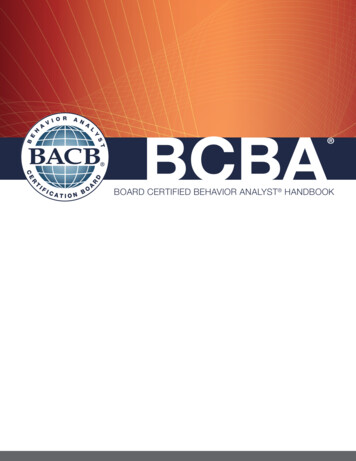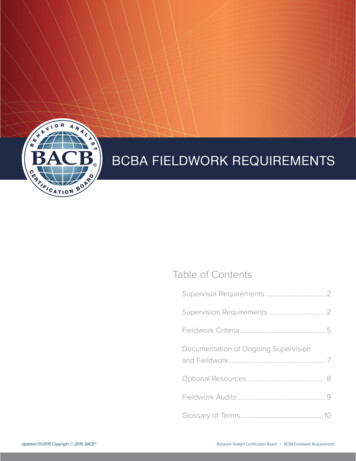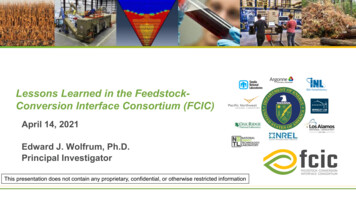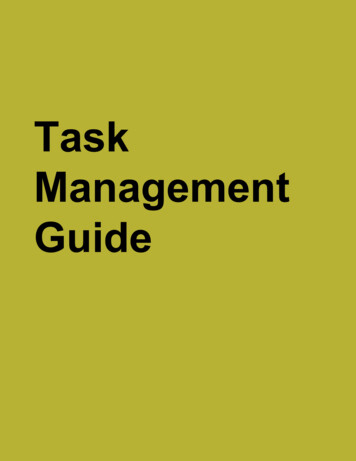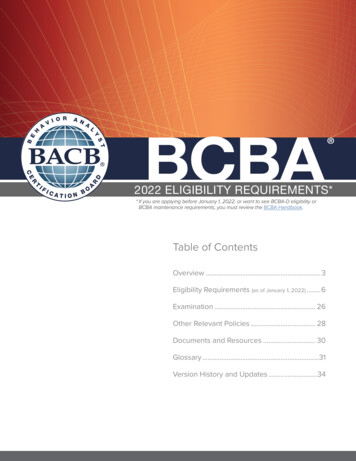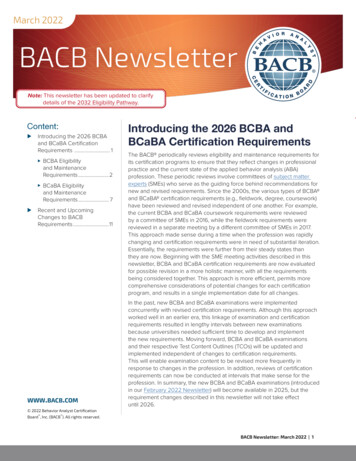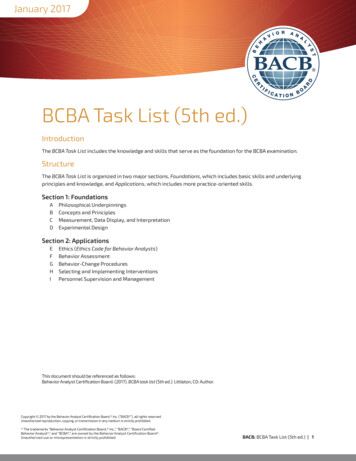
Transcription
January 2017BCBA Task List (5th ed.)IntroductionThe BCBA Task List includes the knowledge and skills that serve as the foundation for the BCBA examination.StructureThe BCBA Task List is organized in two major sections, Foundations, which includes basic skills and underlyingprinciples and knowledge, and Applications, which includes more practice-oriented skills.Section 1: FoundationsABCDPhilosophical UnderpinningsConcepts and PrinciplesMeasurement, Data Display, and InterpretationExperimental DesignSection 2: ApplicationsEFGHIEthics (Ethics Code for Behavior Analysts)Behavior AssessmentBehavior-Change ProceduresSelecting and Implementing InterventionsPersonnel Supervision and ManagementThis document should be referenced as follows:Behavior Analyst Certification Board. (2017). BCBA task list (5th ed.). Littleton, CO: Author.Copyright 2017 by the Behavior Analyst Certification Board, Inc. (“BACB ”), all rights reserved.Unauthorized reproduction, copying, or transmission in any medium is strictly prohibited. The trademarks “Behavior Analyst Certification Board, Inc.,” “BACB ,” “Board CertifiedBehavior Analyst ,” and “BCBA ,” are owned by the Behavior Analyst Certification Board .Unauthorized use or misrepresentation is strictly prohibited.BACB: BCBA Task List (5th ed.) 1
Section 1: FoundationsA. Philosophical UnderpinningsA-1Identify the goals of behavior analysis as a science (i.e., description, prediction, control).A-2Explain the philosophical assumptions underlying the science of behavior analysis (e.g., selectionism,determinism, empiricism, parsimony, pragmatism).A-3Describe and explain behavior from the perspective of radical behaviorism.A-4Distinguish among behaviorism, the experimental analysis of behavior, applied behavior analysis, andprofessional practice guided by the science of behavior analysis.A-5Describe and define the dimensions of applied behavior analysis (Baer, Wolf, & Risley, 1968).B. Concepts and PrinciplesB-1Define and provide examples of behavior, response, and response class.B-2Define and provide examples of stimulus and stimulus class.B-3Define and provide examples of respondent and operant conditioning.B-4Define and provide examples of positive and negative reinforcement contingencies.B-5Define and provide examples of schedules of reinforcement.B-6Define and provide examples of positive and negative punishment contingencies.B-7Define and provide examples of automatic and socially mediated contingencies.B-8Define and provide examples of unconditioned, conditioned, and generalized reinforcers and punishers.B-9Define and provide examples of operant extinction.B-10Define and provide examples of stimulus control.B-11Define and provide examples of discrimination, generalization, and maintenance.B-12Define and provide examples of motivating operations.B-13Define and provide examples of rule-governed and contingency-shaped behavior.B-14Define and provide examples of the verbal operants.B-15Define and provide examples of derived stimulus relations.C. Measurement, Data Display, and InterpretationC-1Establish operational definitions of behavior.C-2Distinguish among direct, indirect, and product measures of behavior.C-3Measure occurrence (e.g., count, frequency, rate, percentage).C-4Measure temporal dimensions of behavior (e.g., duration, latency, interresponse time).C-5Measure form and strength of behavior (e.g., topography, magnitude).Copyright 2017 by the Behavior Analyst Certification Board, Inc. (“BACB ”), all rights reserved.Unauthorized reproduction, copying, or transmission in any medium is strictly prohibited.BACB : BCBA Task List (5th ed.) 2
C-6Measure trials to criterion.C-7Design and implement sampling procedures (i.e., interval recording, time sampling).C-8Evaluate the validity and reliability of measurement procedures.C-9Select a measurement system to obtain representative data given the dimensions of behavior and thelogistics of observing and recording.C-10Graph data to communicate relevant quantitative relations (e.g., equal-interval graphs, bar graphs,cumulative records).C-11Interpret graphed data.D. Experimental DesignD-1Distinguish between dependent and independent variables.D-2Distinguish between internal and external validity.D-3Identify the defining features of single-subject experimental designs (e.g., individuals serve as their owncontrols, repeated measures, prediction, verification, replication).D-4Describe the advantages of single-subject experimental designs compared to group designs.D-5Use single-subject experimental designs (e.g., reversal, multiple baseline, multielement, changingcriterion).D-6Describe rationales for conducting comparative, component, and parametric analyses.Section 2: ApplicationsE. EthicsBehave in accordance with the Ethics Code for Behavior AnalystsE-1IntroductionE-2Responsibility as a ProfessionalE-3Responsibility in PracticeE-4Responsibility to Clients and StakeholdersE-5Responsibility to Supervisees and TraineesE-6Responsibility in Public StatementsE-7Responsibility in ResearchCopyright 2017 by the Behavior Analyst Certification Board, Inc. (“BACB ”), all rights reserved.Unauthorized reproduction, copying, or transmission in any medium is strictly prohibited.BACB : BCBA Task List (5th ed.) 3
F. Behavior AssessmentF-1Review records and available data (e.g., educational, medical, historical) at the outset of the case.F-2Determine the need for behavior-analytic services.F-3Identify and prioritize socially significant behavior-change goals.F-4Conduct assessments of relevant skill strengths and deficits.F-5Conduct preference assessments.F-6Describe the common functions of problem behavior.F-7Conduct a descriptive assessment of problem behavior.F-8Conduct a functional analysis of problem behavior.F-9Interpret functional assessment data.G. Behavior-Change ProceduresG-1Use positive and negative reinforcement procedures to strengthen behavior.G-2Use interventions based on motivating operations and discriminative stimuli.G-3Establish and use conditioned reinforcers.G-4Use stimulus and response prompts and fading (e.g., errorless, most-to-least, least-to-most, promptdelay, stimulus fading).G-5Use modeling and imitation training.G-6Use instructions and rules.G-7Use shaping.G-8Use chaining.G-9Use discrete-trial, free-operant, and naturalistic teaching arrangements.G-10Teach simple and conditional discriminations.G-11Use Skinner’s analysis to teach verbal behavior.G-12Use equivalence-based instruction.G-13Use the high-probability instructional sequence.G-14Use reinforcement procedures to weaken behavior (e.g., DRA, FCT, DRO, DRL, NCR).G-15Use extinction.G-16Use positive and negative punishment (e.g., time-out, response cost, overcorrection).G-17Use token economies.G-18Use group contingencies.G-19Use contingency contracting.G-20Use self-management strategies.Copyright 2017 by the Behavior Analyst Certification Board, Inc. (“BACB ”), all rights reserved.Unauthorized reproduction, copying, or transmission in any medium is strictly prohibited.BACB : BCBA Task List (5th ed.) 4
G-21Use procedures to promote stimulus and response generalization.G-22Use procedures to promote maintenance.H. Selecting and Implementing InterventionsH-1State intervention goals in observable and measurable terms.H-2Identify potential interventions based on assessment results and the best available scientific evidence.H-3Recommend intervention goals and strategies based on such factors as client preferences, supportingenvironments, risks, constraints, and social validity.H-4When a target behavior is to be decreased, select an acceptable alternative behavior to be established orincreased.H-5Plan for possible unwanted effects when using reinforcement, extinction, and punishment procedures.H-6Monitor client progress and treatment integrity.H-7Make data-based decisions about the effectiveness of the intervention and the need for treatmentrevision.H-8Make data-based decisions about the need for ongoing services.H-9Collaborate with others who support and/or provide services to clients.I. Personnel Supervision and ManagementI-1State the reasons for using behavior-analytic supervision and the potential risks of ineffective supervision(e.g., poor client outcomes, poor supervisee performance).I-2Establish clear performance expectations for the supervisor and supervisee.I-3Select supervision goals based on an assessment of the supervisee’s skills.I-4Train personnel to competently perform assessment and intervention procedures.I-5Use performance monitoring, feedback, and reinforcement systems.I-6Use a functional assessment approach (e.g., performance diagnostics) to identify variables affectingpersonnel performance.I-7Use function-based strategies to improve personnel performance.I-8Evaluate the effects of supervision (e.g., on client outcomes, on supervisee repertoires).Copyright 2017 by the Behavior Analyst Certification Board, Inc. (“BACB ”), all rights reserved.Unauthorized reproduction, copying, or transmission in any medium is strictly prohibited. The trademarks “Behavior Analyst Certification Board, Inc.,” “BACB ,” “Board CertifiedBehavior Analyst ,” and “BCBA ,” are owned by the Behavior Analyst Certification Board .Unauthorized use or misrepresentation is strictly prohibited.BACB : BCBA Task List (5th ed.) 5
The BCBA Task List includes the knowledge and skills that serve as the foundation for the BCBA examination. Structure The BCBA Task List is organized in two major sections, Foundations, which includes basic skills and underlying principles and knowledge, and Applications, which includes more practice-oriented skills. Section 1: Foundations
